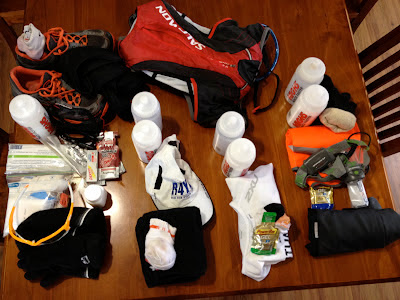Ideal Fatigue
Thanks for the questions Hamburglar. The main goal of this week's training is to determine at what intensity I'll be racing at during Shepparton Half Ironman (HIM). Once I have the weeks data all together, I'll get stuck into the details.
During the bike leg, yes I plan on watching the heart rate. In fact I will basically use heart rate along with monitoring how I feel as my guide for the middle leg. You asked why I don't plan on using a cadence meter. This is a personal thing and I appreciate that many other people find it very helpful to watch their cadence while racing. For me however, I find it has the tendency to slow me down. From experience I have found that by settling into a comfortable or natural cadence not only feels better during the ride, but seems to result in less heaviness on the run when compared to trying to sustain an arbitrary rpm. I don't have science behind me on this one. It simply feels better. Just keep in mind that I don't have a tendency to drop to low cadences, my typical natural range is usually 85-95rpm depending on conditions.
Now for the how long is a piece of string question: What is the ideal fatigue level after the swim and bike?
Not easy to answer. There are so many theories and opinions out there. Naturally you have to take into consideration personal strengths and weaknesses in relation to the course terrain and conditions, your goals for the event plus contingency plans for the unexpected. I'll outline the basic idea of my approach for the upcoming HIM. Again, I'll get into greater detail after this week is over.
During the bike leg, yes I plan on watching the heart rate. In fact I will basically use heart rate along with monitoring how I feel as my guide for the middle leg. You asked why I don't plan on using a cadence meter. This is a personal thing and I appreciate that many other people find it very helpful to watch their cadence while racing. For me however, I find it has the tendency to slow me down. From experience I have found that by settling into a comfortable or natural cadence not only feels better during the ride, but seems to result in less heaviness on the run when compared to trying to sustain an arbitrary rpm. I don't have science behind me on this one. It simply feels better. Just keep in mind that I don't have a tendency to drop to low cadences, my typical natural range is usually 85-95rpm depending on conditions.
Now for the how long is a piece of string question: What is the ideal fatigue level after the swim and bike?
Not easy to answer. There are so many theories and opinions out there. Naturally you have to take into consideration personal strengths and weaknesses in relation to the course terrain and conditions, your goals for the event plus contingency plans for the unexpected. I'll outline the basic idea of my approach for the upcoming HIM. Again, I'll get into greater detail after this week is over.
- Swim: Solid and Fast. Just a bit slower than an all out effort. Personally I don't seem to experience any residual fatigue carrying over from the swim into the rest of the race, so I treat the swim as almost a stand alone event. The only exception is that I don't put in a sprint at the end.
- Bike: Ride at the fastest speed that still allows me to run my fastest run. Check out 2Peak for some interesting analysis of the Hawaiian Ironman this year, where they compared cycling power to running speed. For me it is some data that supports my own beliefs of having an efficient and controlled ride. I have a history of enjoying letting people go way ahead of me on the bike only to bring them back in once I'm on my feet. I always remember reading some time ago Peter Reid stating that after working hard in training on the bike, he noticed he wasn't riding any faster on race day, but that he was able to run faster.
- Run: Don't force the start, allow the legs to find a rhythm then settle into a good pace. Part way in reassess and make minor adjustments. The final third of the run just open it up with whatever I have left.



Thanks for the detailed responce and advice. Look forward to seeing this week's data.
ReplyDeleteBTW - nice link as well!
Interesting about having a bike leg which allows you to run your fastest run. That would be the fastest you can run after having biked at some speed.
ReplyDeleteSo, in long tris, you basically ride at training pace? This is different to time trial cyclists who obviously ride much faster than their general training pace. Interesting.